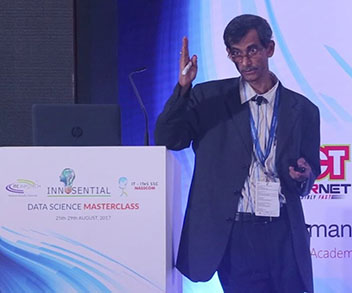Combination of Fuzzy Clustering Algorithms for Change Detection in Remote Sensing Images
In this lecture we will discuss how to combine the output of fuzzy clustering algorithms to detect the changes in remote sensing images. In this regard we select two classical fuzzy clustering algorithms, namely fuzzy c-means (FCM) and Gustafson Kessel clustering (GKC). For clustering purpose various image features are extracted using the neighborhood information of pixels from the difference image. To assign a pixel-pattern to either of two groups (for changed and unchanged regions) maximum of the two membership-values (given by FCM and by GKC for the same pattern for same cluster) is considered. It has been observed experimentally that the changes are detected more efficiently using the proposed ensemble-based procedure. To show the effectiveness of the proposed technique, experiments are conducted on three multispectral and multitemporal remote sensing images. Results are compared with those of existing stand-alone fuzzy clustering based algorithms and found to be superior.
Date and Time
Location
Hosts
Registration
-
 Add Event to Calendar
Add Event to Calendar
- 54 Lomb Memorial Drive
- Rochester, New York
- United States 14623
- Building: Building 76
- Room Number: 1125
- Click here for Map
Speakers
 Ashish Ghosh
Ashish Ghosh
Combination of Fuzzy Clustering Algorithms for Change Detection in Remote Sensing Images
In this lecture we will discuss how to combine the output of fuzzy clustering algorithms to detect the changes in remote sensing images. In this regard we select two classical fuzzy clustering algorithms, namely fuzzy c-means (FCM) and Gustafson Kessel clustering (GKC). For clustering purpose various image features are extracted using the neighborhood information of pixels from the difference image. To assign a pixel-pattern to either of two groups (for changed and unchanged regions) maximum of the two membership-values (given by FCM and by GKC for the same pattern for same cluster) is considered. It has been observed experimentally that the changes are detected more efficiently using the proposed ensemble-based procedure. To show the effectiveness of the proposed technique, experiments are conducted on three multispectral and multitemporal remote sensing images. Results are compared with those of existing stand-alone fuzzy clustering based algorithms and found to be superior.
Biography:
Ashish Ghosh is a Professor & former Head of Machine Intelligence Unit and the In-charge of Center for Soft Computing Research at the Indian Statistical Institute, Calcutta. Received the B.E. degree in Electronics and Telecommunication from the Jadavpur University, Calcutta in 1987, and the M.Tech. and Ph.D. degrees in Computer Science from the Indian Statistical Institute, Calcutta in 1989 and 1993, respectively. He is a fellow of West Bengal Academy of Science and Technology. He received the prestigious and most coveted Young Scientists award in Engineering Sciences from the Indian National Science Academy in 1995; and in Computer Science from the Indian Science Congress Association in 1992. He has been selected as an Associate of the Indian Academy of Sciences, Bangalore in 1997.
He visited the Osaka Prefecture University, Japan with a Post-doctoral fellowship during October 1995 to March 1997; Hannan University, Japan as a Visiting Professor with fellowship from Japan Society for Promotion of Sciences (JSPS) during February-April, 2005. During May 1999 was at the Institute of Automation, Chinese Academy of Sciences, Beijing with CIMPA (France) Fellowship. He was a Visiting Researcher at the National Research Center for Information Technology (GMD), St. Augustin, Germany during January-April, 2000, and at the Aachen University, Germany in September 2010 and May-June 2013 with a European Commission Fellowship. During October-December 2003 he was a Visiting Professor at the University of California, Los Angeles; and during December 2006-January 2007, April 2014 and July 2017 he was at the Computer Science Department of Yonsei University, Korea. He was a Visiting Professor at KMUTT, Thailand during March-April, 2016. His visits to University of Trento &University of Palermo (Italy), University of Porto, Portugal and Hong Kong Polytechnic University, Hong Kong were in connection with collaborative international projects. He also visited various Universities/Academic Institutes and delivered lectures in different countries including South Korea, Poland, Hong Kong, and The Netherlands.
His research interests include Data Science, Data mining and Big Data analysis, Neural and deep learning, Video, colour, medical and remotely sensed image analysis, Pattern recognition and machine learning, Automatic target recognition, Natural computing, Soft computing, Computational intelligence and related topics.
He has edited 10 books, published more than 250 research papers in internationally reputed journals and referred conferences, and is acting as a member of the editorial board/associate editor of various international journals. He served in the capacity of Keynote Speaker, Plenary Speaker, General Chair, Program Chair, Tutorial Chair, and Organizing Chair of many international conferences.
He is a member of the founding team that established the National Center for Soft Computing Research at the Indian Statistical Institute, Kolkata in 2004 with funding from the Department of Science and Technology (DST), Govt. of India; and acting as the Theme Coordinator of Data Science Research initiative of DST, India.
Email:
Address:Indian Statistical Institute, 203 B.T. Road, Kolkata, West Bengal, India, 700108

